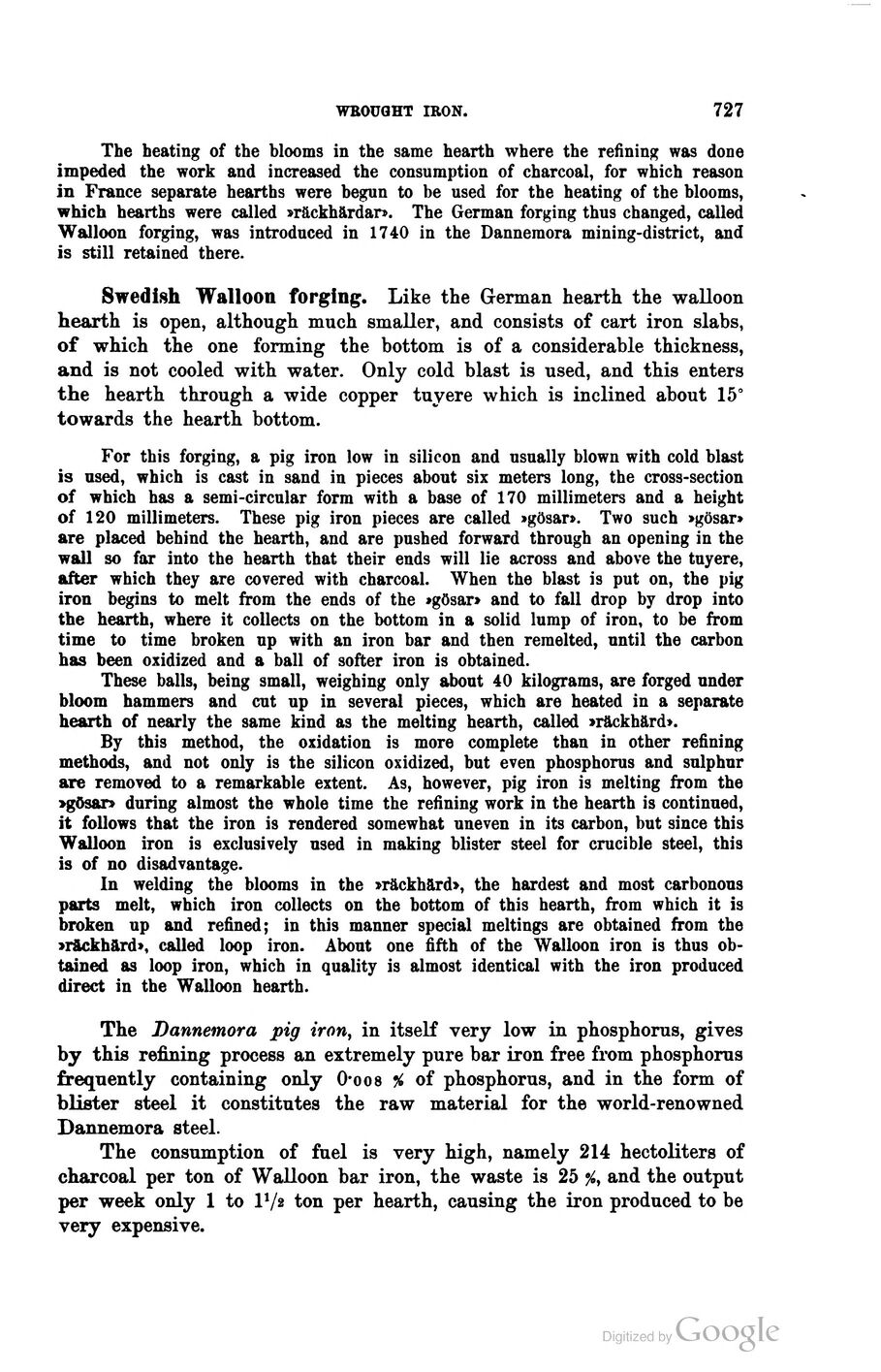
Full resolution (JPEG) - On this page / på denna sida - Second part - IX. Mining Industry and Metal Production - 2. The Iron and Steel Industry. By the late Prof. J. G. Wiborgh - Wrought iron

<< prev. page << föreg. sida << >> nästa sida >> next page >>
Below is the raw OCR text
from the above scanned image.
Do you see an error? Proofread the page now!
Här nedan syns maskintolkade texten från faksimilbilden ovan.
Ser du något fel? Korrekturläs sidan nu!
This page has never been proofread. / Denna sida har aldrig korrekturlästs.
wrought iron.
727
The heating of the blooms in the same hearth where the refining was done
impeded the work and increased the consumption of charcoal, for which reason
in France separate hearths were begun to be used for the heating of the blooms,
which hearths were called »räckhärdar». The German forging thus changed, called
Walloon forging, was introduced in 1740 in the Dannemora mining-district, and
is still retained there.
Swedish Walloon forging. Like the German hearth the Walloon
hearth is open, although much smaller, and consists of cart iron slabs,
of which the one forming the bottom is of a considerable thickness,
and is not cooled with water. Only cold blast is used, and this enters
the hearth through a wide copper tuyere which is inclined about 15°
towards the hearth bottom.
For this forging, a pig iron low in silicon and usually blown with cold blast
is used, which is cast in sand in pieces about six meters long, the cross-section
of which has a semi-circular form with a base of 170 millimeters and a height
of 120 millimeters. These pig iron pieces are called »gösar». Two such »gösar»
are placed behind the hearth, and are pushed forward through an opening in the
wall so far into the hearth that their ends will lie across and above the tuyere,
after which they are covered with charcoal. When the blast is put on, the pig
iron begins to melt from the ends of the »gösar» and to fall drop by drop into
the hearth, where it collects on the bottom in a solid lump of iron, to be from
time to time broken up with an iron bar and then remelted, until the carbon
has been oxidized and a ball of softer iron is obtained.
These balls, being small, weighing only about 40 kilograms, are forged under
bloom hammers and cut up in several pieces, which are heated in a separate
hearth of nearly the same kind as the melting hearth, called »räckhärd».
By this method, the oxidation is more complete than in other refining
methods, and not only is the silicon oxidized, but even phosphorus and sulphur
are removed to a remarkable extent. As, however, pig iron is melting from the
»gösar» during almost the whole time the refining work in the hearth is continued,
it follows that the iron is rendered somewhat uneven in its carbon, but since this
Walloon iron is exclusively used in making blister steel for crucible steel, this
is of no disadvantage.
In welding the blooms in the »räckhärd», the hardest and most carbonous
parts melt, which iron collects on the bottom of this hearth, from which it is
broken up and refined; in this manner special meltings are obtained from the
»räckhärd», called loop iron. About one fifth of the Walloon iron is thus
obtained as loop iron, which in quality is almost identical with the iron produced
direct in the Walloon hearth.
The Dannemora pig iron, in itself very low in phosphorus, gives
by this refining process an extremely pure bar iron free from phosphorus
frequently containing only Ooos % of phosphorus, and in the form of
blister steel it constitutes the raw material for the world-renowned
Dannemora steel.
The consumption of fuel is very high, namely 214 hectoliters of
charcoal per ton of Walloon bar iron, the waste is 25 %, and the output
per week only 1 to l’/s ton per hearth, causing the iron produced to be
very expensive.
<< prev. page << föreg. sida << >> nästa sida >> next page >>